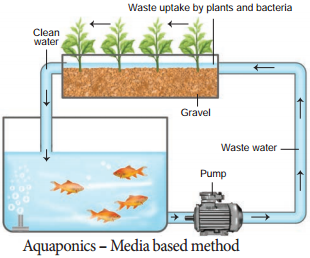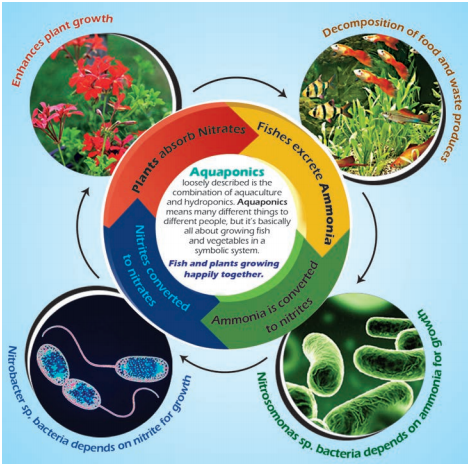Learninsta presents the core concepts of Biology with high-quality research papers and topical review articles.
Aquaponics and its Advantages
Aquaponics is a technique which is a combination of aquaculture (growing fish) and hydroponics (growing plants in non-soil media and nutrient-laden water). Aquaponics may also prevent toxic water runoff. It also maintains ecosystem balance by recycling the waste and excretory products produced by the fish. In India, aquaponics was started in 2013. Some primary methods of aquaponic gardening that are in use nowadays are as follows:
(i) Deep Water Culture
Is otherwise known as raft based method. In this method a raft flats in water. Plants are kept in the holes of raft and the roots flat in water. This method is applicable for larger commercial scale system. By this method fast growing plants are cultivated.
(ii) Media Based
Method involves growing plants in inert planting media like clay pellets or shales. This method is applicable for home and hobby scale system. Larger number of fruiting plants, leafy green plants, herbs and other varieties of plants can be cultivated (Figure 12. 7)
(iii) Nutrient Film Technique
Involves the passage of nutrient rich water through a narrow trough or PVC pipe. Plants are kept in the holes of the pipe to allow the roots to be in free contact with in the water stream.
(iv) Aqua Vertica
Is otherwise known as vertical aquaponics. Plants are stacked on the top of each other in tower systems. Water flows in through the top of the tower. This method is suitable for growing leafy greens, strawberries and other crops that do not need supporting solid substratum to grow.
Advantages of Aquaponic Gardening
Water Conservation:
No need of water discharge and recharge as the water is maintained by recycling process.
Soil:
Bottom soil may be loaded with freshwater. Microbes in water can convert the waste materials into usable forms like ammonia into nitrates which are used by the plants. Thus the soil fertility is maintained.
Pesticides:
In this system use of pesticides is avoided and hence it is ecofriendly.
Weeds:
Since the plants are cultured in confined conditions, growth of weeds is completely absent. The utilization of nutrient by plants is high in this method.
Artificial Food for Fishes:
In this system plant waste and decays are utilized by fishes as food. So, the need for the use of supplementary feed can be minimized.


Fertilizer Usage:
Artificial or chemical fertilizers is not required for this system since the plants in the aquaponics utilize the nutrients from the fish wastes dissolved in water.
Cultivable fishes like tilapia, trout, koi, gold fish, bass etc., are cultured in aquaponics. Common cultivable plants like tomato, pepper, lettuce, cucumber, and rose are co-cultivated in this method.